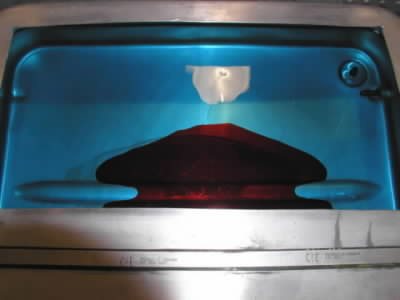The 150's tanks are almost flat-bottomed, with a slight depression near the fuel outlet to the engine. The sump is in a higher spot in the back corner. Unless the airplane is sitting tail-low, water can remain in the tank.
In the OP's airplane, which has rubber bladders, water gets trapped behind wrinkles across the bladder's bottom and doesn't drain to the sump. Those wrinkles typically run diagonally across the tank, inboard front to outboard aft, forming dams. Cessna sells a kit to move the sump drain valve inboard and aft to pull those wrinkles out, but old bladders are stiff and don't comply too well.
Fuel bladder AD and inspection
In 1984 AD 84-10-01 was issued; it was later revised. The current AD is 84-10-01R1. This AD was written because there was a series of engine power interruptions soon after takeoff in fuel bladder-equipped Cessnas.
Instead of addressing the cause of the problem—leaking fuel caps—the AD required owners to determine if there were diagonal wrinkles in the bottom surface of the bladders. Water, let in by the leaking caps, would “hide” behind the wrinkles while the tanks were being sumped.
The owner, thinking his tanks were full of good fuel, would take off. When the water jumped over the wrinkle it would be ingested by the engine causing a power loss.
The AD instructed owners that found wrinkles to drain the tanks to determine if the fluid behind the wrinkle was greater than three fluid ounces.
If more than three ounces were found, the AD required that a placard be placed on the panel calling for a procedure where the tail was lowered to within five inches of the ground and the wings moved up and down (a total of 10 inches up and 10 inches down, at least 12 times; the famous “rock and roll” preflight procedure) until no more water was being sumped out of the tank.
The AD mandated a modification to the fuel tank sump drain valve on each tank. The details of this procedure are in SE 84-09R2; modification kits SK206-24 and -25 sell for around $800 each.
The AD also required the installation of small diameter raised-lip fuel caps (SK182-85B) or an alternate method of compliance. The Monarch-style caps mentioned above are the best solution.
From
https://www.cessnaflyer.org/cessna-.../1034-inspection-tips-for-the-cessna-182.html
Edit: This bladder-wrinkle problem is so severe that even in the taildraggers, 180s and 185s, it causes problems.
The Cessna 150/152 problem, I believe, is because Cessna carried the 120/140 tanks into the 150. The taildraggers naturally got the water to migrate to the sump drain in spite of the shallow low spot near the fuel outlet. Making a trike of the airplane should have mandated a different tank configuration, but it was overlooked or something, and now we have a problem.
Those tanks were smooth aluminum, not rubber that easily wrinkles.





